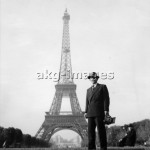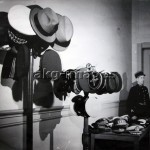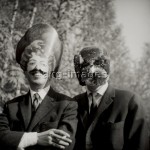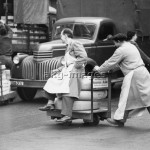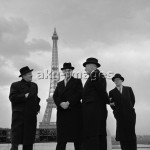The Organ Grinder

Left: 2-G82-S4-1955 © akg-images / Paul Almasy.
Right: 2-G82-S4-1956-1 © akg-images / Peter Cornelius.
I was looking through a drawer of prints by Paul Almasy (Hungarian photographer, 1906–2003) last month when a familiar face appeared before me. Where had I seen this face before? The date of the black and white photo was 1955. The bearded man in the photo was dressed in a dark jacket, his trousers patched at the knee, a large hat perched on his head – and so he sat on a bench above the River Seine, grinding his street organ for the passing pedestrians of Paris. I had a clear image in my mind of this same man, in colour, seated beside a young blond girl in a pink skirt. It was then that I remembered a very similar shot by Peter Cornelius (German photographer, 1913–1970). My curiosity got the better of me and I dug around the akg archive to find the image that had sparked this memory. Et voilà! There it was, a very early colour photograph of Paris showing the same man, around one year later in 1956, almost unaltered in place and time. This coincidence brought me to think about the intertwined paths of some of our akg photographers and how their personal journeys must have overlapped during their careers.
The Paris of the 1940s, 1950s and 1960s was a hub for creative minds. The city’s beauty and bohemian lifestyle attracted many artists, writers and photographers to call Paris their home. Whilst Denise Bellon (French photographer, 1902-1999) began passionately following the Surrealist art movement with her camera, Ingi (French photographer, full name Louis Ingigliardi) was combining his professional career as a cellist with his love for photography by shooting leading figures from the Parisian music scene. Meanwhile, Jacques Rouchon (French photographer, 1923-1981) gained backstage camera access to the Folies Bergères and later began making a name for himself as a prime fashion and advertising photographer in the world of Parisian haute couture.

Model on a balcony in Paris, 1958.
© Jacques Rouchon / akg-images
The charm of everyday Parisian life was perfectly captured by the likes of Paul Almasy and Peter Cornelius: elegant ladies leisurely sipping their drinks on café terraces, the winding cobbled streets of Montmartre, the hustle and bustle of market vendors and the banks of the river Seine. Almasy’s photos of Paris express the post-war spirit of the city from the end of the German occupation all the way to the careless rock ‘n’ roll days of the 1960s. Cornelius’ pioneering use of colour photography portrays 1950s Paris in a new light that was revolutionary for its time.

Man walking along the Rue Saint-Vincent in Paris, 1956-1961.
© akg-images / Peter Cornelius
On the political front, post-war peace negotiations in Paris and the subsequent tumultuous upheaval during De Gaulle’s presidency have been well documented by Yevgeny Khaldei (Russian photographer, 1917-1997) and Erich Lessing (Austrian photographer, born 1923) respectively.
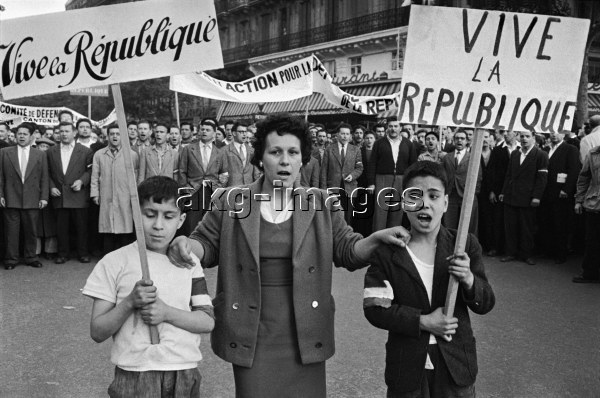
Anti-de Gaulle demonstration in Paris, May 1958.
© akg-images / Erich Lessing
Alone, each of these akg photographers brings something unique to the table, a glimpse of a bygone Paris. Yet it is only together that they can give us a comprehensive understanding of this city’s past, like a jigsaw puzzle starting to take shape once several pieces have been put together. How many of them would have passed the bearded organ grinder on the Seine, I wonder, and how many might have thrown some centimes in his busker’s case?
Ballerina Claude Bessy on stage, 1959.
© akg-images / Ingi
Photographer Yevgeny Khaldei in Paris, 1946.
© akg-images / Voller Ernst / Yevgeny Khaldei
Woman in street café, 1956.
© akg-images / Paul Almasy
Paris Peace Conference, July 1946.
© akg-images / Voller Ernst / Yevgeny Khaldei
Surrealists Robert Benayoun and Alain Joubert, 1960.
© akg-images / Denise Bellon
Ceremonies after the death of De Gaulle at Notre Dame, Paris, November 1970: A young woman who swooned is helped by police.
© akg-images / Erich Lessing
Rock’n’Roll on the banks of the River Seine, Paris, 1950s.
© akg-images / Paul Almasy
Young woman at a book stall in Paris, c. 1955.
© akg-images / Paul Almasy
Delivery of cheese in front of the Parisian market ‘Les Halles’, c. 1950.
© akg-images / Paul Almasy
Jacques Rouchon during a fashion shoot in Paris, 1958.
© akg-images / Christian Lemaire
Portrait of photographer Paul Almasy, 1969.
© akg-images / Jean Dieuzaide
Adenauer in Paris, April 1951.
© akg-images / Erich Lessing

